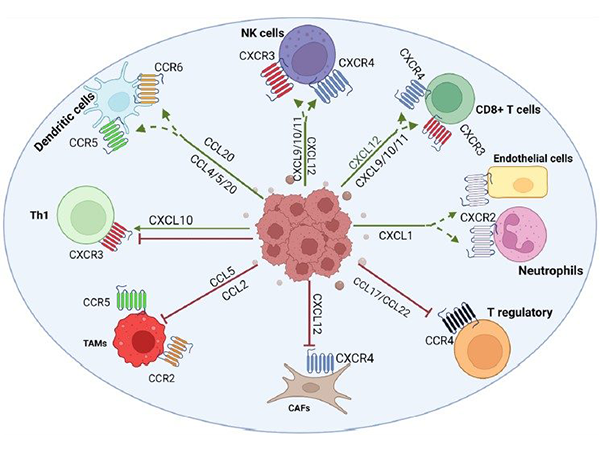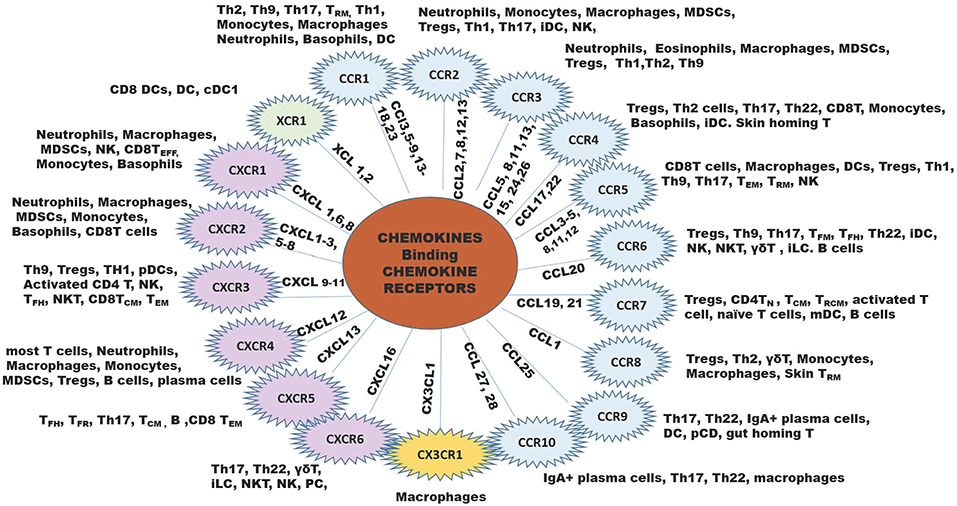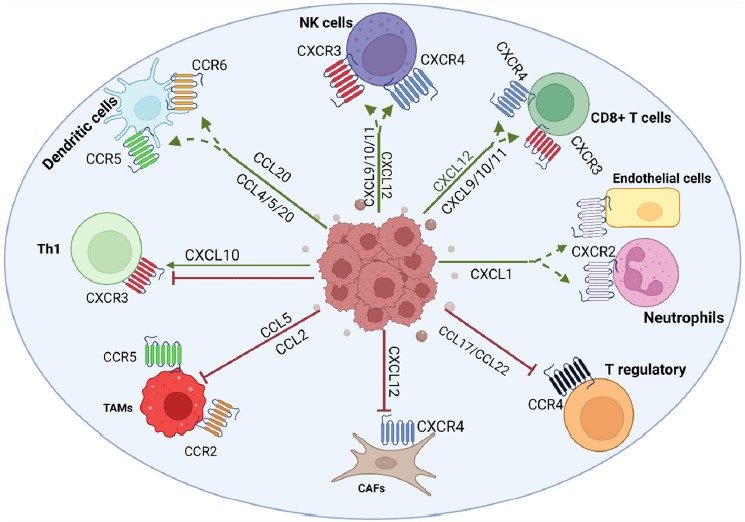Entering the Family of Chemokines

Chemokines are a class of small cytokines or signaling proteins secreted by cells. They possess the ability to induce the directional chemotaxis of nearby responding cells and exert their biological effects through interacting with G protein-coupled transmembrane receptors (known as chemokine receptors, which are selectively expressed on the surface of target cells).
Chemokines and chemokine receptors play a crucial role in mediating cell migration, proliferation, and the defense against pathogen invasion, and are closely associated with the occurrence and development of inflammation and cancer in the immune environment.
The Discovery of Chemokines
In 1977, Walz and his colleagues discovered the first chemokine - platelet factor 4 (now named CXCL4). Initially, it was regarded as a procoagulant and angiogenesis-inhibiting factor, and at that time, people were not aware that it belonged to a large and functionally unique family. Subsequently, from 1984 to 1989, a series of structurally related cDNAs were cloned, such as IP-10, JE, Mig, etc., but the key function of chemokines in inducing cell chemotaxis was still not emphasized. It was not until the chemotactic property of interleukin 8 (IL-8, namely CXCL8) towards neutrophils was revealed that the unique functions of chemokines came into the spotlight.
In 1992, the term "chemokines" was officially coined at the Third International Symposium on Chemotactic Cytokines, marking the entry of the research on this family into a new stage. Since then, with the discoveries that monocyte chemoattractant protein 1 (MCP-1), regulated upon activation normal T cell expressed and secreted (RANTES), and eotaxin could target different types of white blood cells respectively, as well as the confirmation of the association between chemokine receptors and HIV-1 and their roles in tissue-specific homing, the research in the field of chemokines has entered a period of vigorous development.
The Classification and Structure of Chemokines
Chemokines are a family of structurally related cytokines, most of which are secreted proteins with a molecular weight of approximately 10kDa. The α-helical structure at the carboxyl terminus endows them with the ability to preferentially bind to proteoglycans on vascular endothelial cells and extracellular matrix proteins, and the four highly conserved cysteine residues serve as an important basis for their classification. According to the number and spacing of N-terminal cysteine residues, chemokines are classified into four subfamilies: CXC, CC, XC, and CX3C.
The CXC subfamily contains numerous members such as CXCL1-17. For example, CXCL8 (IL-8) plays a crucial role in the chemotaxis of neutrophils during the inflammatory response. The CC subfamily has many members from CCL1 to CCL28. For instance, CCL2 (MCP-1) mainly acts on monocytes. The XC subfamily only has XCL1 and XCL2, and the CX3C subfamily only has CX3CL1. Each member of the subfamily has its unique gene symbol and alias, and together they constitute a large and well-organized family system of chemokines.

The Functions of Chemokines
The key to the function of chemokines lies in their binding to G protein-coupled receptors with seven transmembrane domains. After binding, the α and βγ subunits of the G protein dissociate, which in turn activates pathways such as mitogen-activated protein kinase (MAPK), phosphatidylinositol 3-kinase (PI-3K), and phospholipase C (PLC), leading to an increase in the intracellular calcium level and ultimately promoting cell polarization, adhesion, and migration. The most well-known function of chemokines is to guide cell migration, especially that of white blood cells. It is like a "navigator" for cells, capable of stimulating white blood cells to migrate directionally along the concentration gradient and participating in immune defense and inflammatory responses. In addition to chemotaxis, chemokines can also regulate cell proliferation, survival, and differentiation, promote the production of cytokines, and even have direct antibacterial activity. Non-white blood cell types, such as neurons and epithelial cells, can also express chemokine receptors and respond to chemokines.
Under physiological conditions, chemokines are indispensable for maintaining the immune balance and tissue homeostasis of the body. They guide white blood cells to accurately locate the sites of infection or injury, initiate immune responses, and simultaneously participate in the processes of angiogenesis and organ development. However, under pathological conditions, chemokines can be a "double-edged sword". In autoimmune diseases, allergic reactions, and chronic inflammatory diseases, the chemokine-directed migration of white blood cells can lead to excessive immune responses and tissue damage. In the field of cancer, cancer cells cleverly utilize the chemokine system to alter the tumor microenvironment, promoting the survival, proliferation, and metastasis of tumor cells. For example, tumor cells secrete chemokines to attract immunosuppressive cells, creating a microenvironment conducive to tumor growth, and can also use chemokines to guide tumor cells to metastasize to distant sites.

The Clinical Application of Chemokines
Given the crucial role of chemokines in various diseases, their application prospects in clinical treatment have attracted much attention. In terms of inflammatory diseases, the development of drugs that can block the chemokine signaling pathway is expected to inhibit excessive inflammatory responses and reduce tissue damage. For example, antagonists targeting certain chemokine receptors have entered the clinical trial stage, aiming to treat diseases such as rheumatoid arthritis and inflammatory bowel disease. In cancer treatment, interfering with the chemokine-mediated migration and immune escape of tumor cells has become a potential treatment strategy. On the one hand, monoclonal antibodies against chemokines or their receptors can be developed to block the "communication" between tumor cells and the microenvironment. On the other hand, by regulating the expression of chemokines, the tumor microenvironment can be remodeled to enhance the body's anti-tumor immune response.
The large number of members and functional redundancy within the chemokine family pose great challenges to clinical applications. There may be complex interactions among different chemokines, and the intervention of a single target may trigger compensatory changes in other chemokines, affecting the treatment effect. In addition, due to the importance of chemokines in normal physiological processes, completely blocking their functions may lead to serious side effects. Therefore, how to precisely target specific chemokines or their receptors, while inhibiting disease progression, minimizing the impact on normal physiological functions, is currently the focus and difficulty of research.
Conclusion
The Chemokines family, as an important member in the field of cytokines, has extremely high research value in both basic biology and clinical applications. Although there are currently many challenges in the process of clinical translation, with the continuous deepening of research, it is expected to further reveal the mysteries of chemokines, develop more precise and effective treatment strategies, and bring new hope to human health undertakings.
Product Information
| Gatalog Num | Product Name | Product Parameters | Price |
| S0B0925 | CXCR2 Recombinant Rabbit mAb (S-1292-30) | Host : Rabbit | Inquiry |
| Conjugation : Unconjugated | |||
| S0B1160 | CXCL10/IP-10 Rabbit Polyclonal Antibody | Host : Rabbit | Inquiry |
| Conjugation : Unconjugated | |||
| S0B0706 | CXCR3 Recombinant Rabbit mAb (S-377-8) | Host : Rabbit | Inquiry |
| Conjugation : Unconjugated | |||
| S0A4062 | Mouse CXCL10/IP-10/CRG-2 Protein, hFc tag | Host : Mouse | $210 |
| Expression System : HEK293 | |||
| Conjugation : Unconjugated | |||
| S0A4067 | Mouse CXCL10/IP-10/CRG-2 Protein | Host : Mouse | Inquiry |
| Expression System : HEK293 | |||
| Conjugation : Unconjugated | |||
| UA040084 | MIP-3α/CCL20 Protein, Human | Host : Human | $162 |
| Expression System : E.coli | |||
| Conjugation : Unconjugated | |||
| UA040286 | CCL15/MIP-1δ/LKN-1(68aa) Protein, Human | Host : Human | $156 |
| Expression System : E.coli | |||
| Conjugation : Unconjugated | |||
| UA040307 | CCL14a/HCC-1(66aa) Protein, Human | Host : Human | $164 |
| Expression System : E.coli | |||
| Conjugation : Unconjugated | |||
| UA040305 | CCL14a/HCC-1(72aa) Protein, Human | Host : Human | $164 |
| Expression System : E.coli | |||
| Conjugation : Unconjugated | |||
| UA040321 | CCL17/TARC Protein, Human | Host : Human | $116 |
| Expression System : E.coli | |||
| Conjugation : Unconjugated | |||
| UA040377 | CCL17/TARC Protein, Mouse | Host : Mouse | $116 |
| Expression System : E.coli | |||
| Conjugation : Unconjugated | |||
| UA040353 | CCL2(73aa) Protein, Mouse | Host : Mouse | $270 |
| Expression System : E.coli | |||
| Conjugation : Unconjugated | |||
| UA040282 | CCL7/MCP-3 Protein, Human | Host : Human | $192 |
| Expression System : E.coli | |||
| Conjugation : Unconjugated | |||
| UA040183 | CXCL4 Protein(C-6His) Protein, Human | Host : Human | $232 |
| Expression System : HEK293 | |||
| Conjugation : Unconjugated | |||
| UA040167 | CXCL14/BRAK Protein, Mouse | Host : Mouse | $178 |
| Expression System : E.coli | |||
| Conjugation : Unconjugated | |||
| UA040191 | CXCL10 Protein, Mouse | Host : Mouse | $964 |
| Expression System : E.coli | |||
| Conjugation : Unconjugated | |||
| UA040114 | CXCL1 Protein, Human | Host : Human | $162 |
| Expression System : HEK293 | |||
| Conjugation : Unconjugated | |||
| UA040222 | MIG/CXCL9 Protein, Human | Host : Human | $180 |
| Expression System : E.coli | |||
| Conjugation : Unconjugated | |||
| UA040133 | MIG/CXCL9 Protein, Mouse | Host : Mouse | $156 |
| Expression System : E.coli | |||
| Conjugation : Unconjugated | |||
| UA040196 | IL-8/CXCL8 Protein, Canine | Host : Canine | $316 |
| Expression System : E.coli | |||
| Conjugation : Unconjugated | |||
| S0B1019P | S-RMab® MCM2 Recombinant Rabbit mAb,PBS Only (SDT-018-68) | Host : Rabbit | Inquiry |
| Conjugation : Unconjugated | |||
| S0B1019 | S-RMab® MCM2 Recombinant Rabbit mAb (SDT-018-68) | Host : Rabbit | $880 |
| Conjugation : Unconjugated | |||
| S0B3361 | CCL2/MCP-1 Recombinant Rabbit mAb (SDT-1737-66) | Host : Rabbit | $950 |
| Conjugation : Unconjugated | |||
| S0B3362 | CCL2/MCP-1 Recombinant Rabbit mAb (SDT-1737-79) | Host : Rabbit | $950 |
| Conjugation : Unconjugated | |||
| S0B3359 | CCL2/MCP-1 Recombinant Rabbit mAb (SDT-1737-4) | Host : Rabbit | $950 |
| Conjugation : Unconjugated | |||
| S0B3360 | CCL2/MCP-1 Recombinant Rabbit mAb (SDT-1737-6) | Host : Rabbit | $950 |
| Conjugation : Unconjugated | |||
| S0B1045 | CCR8 Recombinant Rabbit mAb (S-1414-148) | Host : Rabbit | Inquiry |
| Conjugation : Unconjugated | |||
| S0B0677 | CCR7 Recombinant Rabbit mAb (S-999-29) | Host : Rabbit | Inquiry |
| Conjugation : Unconjugated | |||
| S0B0439 | CCR7 Recombinant Rabbit mAb (S-R333) | Host : Rabbit | Inquiry |
| Conjugation : Unconjugated | |||
| S0A9001 | CCoV N protein , His tag | Expression System : E.coli | Inquiry |
| Conjugation : Unconjugated | |||
| S0B0022P | ERCC1 Recombinant Rabbit mAb,PBS Only (SDT-R056) | Host : Rabbit | Inquiry |
| S0B1272 | Succinyllysine Rabbit Polyclonal Antibody | Host : Rabbit | Inquiry |
| Conjugation : Unconjugated | |||
| S0B3375 | CXCL10/IP-10 Recombinant Rabbit mAb (SDT-1910-136) | Host : Rabbit | $170 |
| Conjugation : Unconjugated | |||
| S0B0104P | CXCR5 Recombinant Rabbit mAb,PBS Only (SDT-351-24) | Host : Rabbit | Inquiry |
| S0B3372 | CXCL10/IP-10 Recombinant Rabbit mAb (SDT-1910-35) | Host : Rabbit | $170 |
| Conjugation : Unconjugated | |||
| S0B3373 | CXCL10/IP-10 Recombinant Rabbit mAb (SDT-1910-56) | Host : Rabbit | $170 |
| Conjugation : Unconjugated | |||
| S0B3374 | CXCL10/IP-10 Recombinant Rabbit mAb (SDT-1910-59) | Host : Rabbit | $170 |
| Conjugation : Unconjugated | |||
| S0B1421 | CXCL10/IP-10 Recombinant Rabbit mAb (S-1910-59) | Host : Rabbit | Inquiry |
| Conjugation : Unconjugated | |||
| S0B0889 | CXCL9/MIG Recombinant Rabbit mAb (S-1314-35) | Host : Rabbit | Inquiry |
| Conjugation : Unconjugated | |||
| S0B0104 | CXCR5 Recombinant Rabbit mAb (SDT-351-24) | Host : Rabbit | $350 |
Reference
1. Zlotnik A, Yoshie O. The chemokine superfamily revisited. Immunity. 2012 May 25;36(5):705-16
2. Vilgelm AE, Richmond A. Chemokines Modulate Immune Surveillance in Tumorigenesis, Metastasis, and Response to Immunotherapy. Front Immunol. 2019 Feb 27;10:333.
3. Hughes CE, Nibbs RJB. A guide to chemokines and their receptors. FEBS J. 2018 Aug;285(16):2944-2971.




